West Virginia State Science Standards
Students in grades 9—12 will:
Content Standard 1: The Nature of Science
SC.S. 1 Demonstrate the ability to use the inquiry process to solve problems.
SC.S.O.1.1 Formulate scientific explanations based on historical observations and experimental evidence, accounting for variability in experimental results.
SC.O.1.2 Demonstrate how a testable methodology is employed to seek solutions for personal and societal issues.
SC.O.1.6 Use appropriate technology solutions within a problem solving setting to measure and collect data, interpret data, analyze and/or report data, interact with simulations, conduct research, and present and communicate conclusions.
SC.O.1.8 Draw conclusions from a variety of data sources to analyze and interpret systems and models (e.g. use graphs and equations to measure and apply variables such as rate and scale, evaluate changes in trends and cycles, predict the influence of external variances such as potential sources of error, or interpret maps.
Content Standard 2: Content of Science
Physical Science
SC.S.PS.2 Demonstrate an understanding of the interrelationships among physics, chemistry, biology, earth/environmental science, an astronomy; and apply knowledge, understanding and skills of science subjects matter/concepts to daily life
Environmental Science
SC.O.ENV.2.10 Analyze biological diversity as it relates to the ecosystem.
SC.O.ENV.2.14 Identify natural and anthropogenic sources of secondary and indoor air pollutants and environmental and health effects.
SC.O.ENV.2.16 Identify causes for the thinning of the ozone layer and evaluate the effectiveness of the Montreal Protocol in reducing ozone depletion.
SC.O.ENV.2.17 Debate climate changes as it relates to greenhouse gases and human changes in atmospheric concentrations of greenhouse gases and relevant laws.
SC.O.ENV.2.1 Compare and contrast the rate elements cycle through the ecosphere, describing natural and human influences on reaction rates (carbon, nitrogen, phosphorus, oxygen)
SC.O. ENV. 2.2 Predict the effects of human activities on biogeochemical cycles as they affect water quality, air quality, recycling, and climate change
SC.O.ENV.2.9 Evaluate the leading cases of species decline and premature extinction
Biology
SC.B.2.21 Propose ecosystem models that incorporate interactions of biotic and abiotic environmental variables in biogeochemical cycles
SC.O. B. 2.18 predict and assess responses of organisms to internal and environmental stimuli
SC.O. B. 2.19 Examine the cycle of viruses and compare disease prevention
SC.O. B. 2.20 Evaluate environmental factors that affect succession, populations and communities
Conceptual Biology
SC.O.CB. 1.5 Draw conclusions from a variety of data sources to analyze and interpret system and models (e.g. use graphs…to measure and apply variables, evaluate changes in trends and cycles…)
SC.O.CB. 2.22 Predict the effects of human activities on biogeochemical cycles of matter and energy in the biosphere over time (water quality, air quality, recycling, climate change)
SC.O.CB.2.16 Examine the cycle of viruses and compare disease prevention (vector control)
Human Anatomy & Physiology
SC.O. HAP. 2.24 research disease causative factors, symptoms, prevention and treatment
Earth Science
SC.O.ES.2.17 Investigate to explain heat transfer in the atmosphere and its relationship to meteorological processes
SC.O.ES.2.1 Examine global change over time (climate change, global warming, ozone depletion)
Content Standard 3: Application of Science
SC.S.3 Demonstrate an understanding of the interdependence between science and technology.
SC.S.3 Demonstrate an understanding of the utilization of technology to gather data and communicate designs, results and conclusions.
SC.3. Demonstrate an understanding of personal and societal benefits of science and an understanding of public policy decisions as related to health, population, resource, and environmental issues.
Source: 21st CENTURY SCIENCE 9-12 CONTENT STANDARDS AND OBJECTIVES FOR
WEST VIRGINIA SCHOOLS (2520.35)
http://wvde.state.wv.us/policies/p2520.35_ne.pdf



